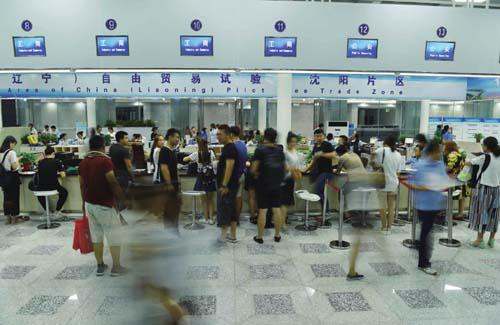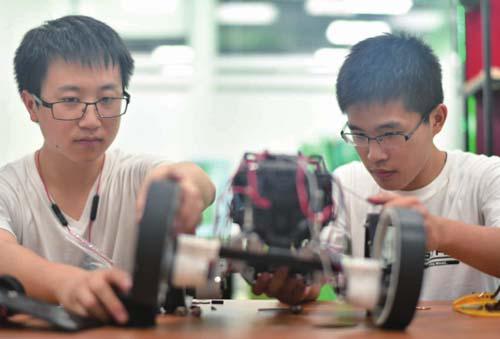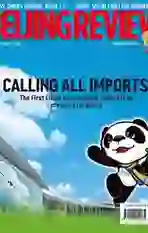The Full Picture
2018-08-24



The United States submitted a paper on “Chinas trade-disruptive economic model”to a World Trade Organization (WTO) meeting on July 26. In response to the paper and criticism by U.S. Permanent Representative to the WTO Dennis Shea, Zhang Xiangchen, Permanent Representative of China to the WTO, expounded on a number of widely followed issues ranging from how Chinas market economy functions to the effect of its industrial policies. An edited excerpt of Zhangs statement follows:
Back in 1992, when China announced that it would build a socialist market economy, a question was posed to a Chinese delegate: What is a socialist market economy? I clearly remember this delegate replying that the socialist market economy is a market economy under the leadership of the Communist Party of China (CPC). Twentysix years have passed since then and we have never changed our position. As for those who speculated that China would change and move onto a different path upon its accession to the WTO, that was just their wishful thinking. There is more than one market economy model in this world. China has been vigorously exploring a market economy path which suits its own national situation and circumstances, and we have made remarkable progress in this endeavor. Whatever others may say, we will march along this road unswervingly.
In his remarks, Ambassador Shea mentioned the term “non-market nature of Chinas economy.” However, we cant find the definition of “market economy” anywhere in the WTO rule book. There is no one-size-fits-all market economy standard in the world. WTO rules never authorize any member to use its own economic model as the template for a market economy or to accuse any other member that does not copy it of being a non-market economy.
If there is any relevance to the topic of a non-market economy, it reminds us once again that there are certain members—including the United States—who, disregarding WTO rules and their own commitments, are still using the notorious“surrogate country” methodology in antidumping investigations according to the market economy standards of their own domestic laws. I would like to take this opportunity to urge these members once again, “pacta sunt servanda.” Please honor your commitments from 17 years ago.
Striking a balance
Paragraph 1.5 of the U.S. paper partially quoted an expression from the communiqué of the Third Plenary Session of the 18th Central Committee of the CPC: “The government plays its role better.” The U.S. paper intentionally omitted the rest of the sentence, which stated that the market should play a decisive role in allocating resources. In this regard, it is critically important to recognize the decisive role that the market plays in allocating resources, as this is precisely the economic and institutional basis upon which China promotes its economic and trade relations with other WTO members.
Please allow me to give you the full quote of the entire paragraph in the communiqué. “Economic structural reform is the focus of deepening the reform comprehensively. The underlying issue is how to strike a balance between the role of the government and that of the market, letting the market play the decisive role in allocating resources and the government play its role better. It is a general rule of the market economy that the market decides the allocation of resources. We have to follow this rule when we improve the socialist market economy. We should work hard to address the problems of imperfections in the market system, too much government interference and poor oversight.”
Similarly, the preamble of the U.S. paper partially quoted the Marrakesh Declaration of 1994, where it stated that the multilateral trading system should be “based upon open, market-oriented policies.” However, the paper intentionally omitted the rest of the sentence, which said, “and the commitments set out in the Uruguay Round Agreements and Decisions.” This second half of the sentence is extremely important, as each member has its own domestic policy objectives, showing that the results of multilateral negotiations are a balance between members domestic policies and the process of global trade liberalization.
Such balance is reflected in memberstrade rules, tariff schedules and services schedules, which contain descriptions of members legitimate regulatory policies and measures. To put it simply, the WTO Agreement is a set of contracts achieved through negotiations. Within the scope of these contracts, members abide by the conditions set forth in the contracts. Beyond the scope of these contracts, members have their own policy space.
Controlling enterprises?
Article 16 of Chinas Constitution clearly states that state-owned enterprises have decision-making power over their operations and management. The U.S. paper spent many paragraphs trying to argue that the Chinese Government “controls” enterprises. But the paper failed to provide evidence to prove that the government intervenes in the normal operations of the enterprises.
I once had a debate with a U.S. senior offi cial over this issue. He later conceded that he was unable to provide evidence. At the end of our debate, he said that control is not a science, it is an art. With such words, the debate was adjourned. But for me, I would not agree with the notion that thousands of enterprises in China are controlled by a group of artists.

It is known to many colleagues present today that the real purpose of the U.S. intent is not only to try to prove that Chinese enterprises are controlled by the government,but also to try to establish a kind of logic. That is, so long as enterprises are controlled by the government, they therefore assume and perform part of government functions and therefore should be deemed as“public bodies” in the context of the WTO and should undertake obligations under WTO agreements such as the Subsidies and Countervailing Agreement.
Unfortunately, such logic was overturned by the WTOs Appellate Body. In the U.S.-China Anti-Dumping and Countervailing Duties case, the Appellate Body stated that“the mere ownership or control over an entity by a government, without more, is not sufficient to establish that the entity is a public body.” I was told that our American colleagues have been quite unhappy with losing this case, but the ruling of the Appellate Body cannot be challenged.
Let me give you another example. In Paragraph 1.14 of the paper, the United States questioned China for using a “social credit system” as a “new tool to monitor, rate and condition the conduct of all enterprises in China.” But the fact is that such a system is meant to create a fair and credible business environment and prevent fraud and misbehavior. And Chinas social credit system is based on the experiences of over 60 countries that have established a similar public credit system, including France and Germany. Is it simply because of its differences with that of the United States that such a system becomes a tool to monitor and control enterprises?
Industrial policies
Developed countries are the inventors and major users of industrial policies and subsidies. It was actually Alexander Hamilton who pioneered the concept of industrial policies in his 1790 Report on the Subject of Manufactures. Today, the U.S. Advanced Manufacturing Partnership and the U.S. National Information Infrastructure, to name a few, are key industrial policies in the United States. According to Good Jobs First, a U.S. national policy resource center that tracks subsidies, the U.S. Federal Government allocated a total of $68 billion in the form of government grants and tax credits from 2000 to 2015.
Like other countries, China also has developed some industrial policies for strategic and planning purposes. These policies have played a certain role in Chinas social and economic development. But in the U.S. paper, these policies are described as rocket engines, which is plainly exaggerating. If that were the case, there would be no need for any country to work hard and enhance its productive capacity, since all countries could just simply rush to draw up fancy industrial policies.
In this regard, I can share some personal experiences. Several years ago, I served as director general of the Policy Research Department of the Ministry of Commerce and was involved in developing some plans. A former colleague from that department recently visited me, saying with a bit of surprise and confusion, “I used to feel frustrated quite often with the actual effect of the plans that I had joined in developing, but happily now some people are saying these plans have changed China and shocked the world. I never realized that I myself and my plan could be so powerful.” I said to him, “Wake up, you should know better what those plans can do.”
Let us get back to the U.S. paper. Paragraph 2.9 argued that Chinas planned economy “has become more, not less salient over the past 20 years.” The evidence used to support this argument is that thousands of agencies participate in planning industrial policies. To me, these facts only prove that the mechanism for setting industrial policies has become more open and transparent, that government agencies making policies increasingly rely on extensive consultations with stakeholders.
Logical inconsistencies
In Section 4 of the U.S. paper, titled Benefits to China of Its Economic Model, the United States pointed to several facts, such as “China has seized on the benefi ts of its WTO membership to rapidly develop its economy,” and the lower cost of Chinas manufacturing is owed to “economies of scale and more advanced supply-chain development.” But from these facts, this section jumps to questioning Chinas status as a developing country and criticizing China for exempting itself from contributing to the liberalization of global trade rules, without providing any cause and effect analysis. It is hard to see how Chinas development has benefi ted from its developing country status. All countries and regions join the WTO with a view to developing their economies, a principle stated in the preamble of the WTO Agreement. The reason why China has been able to make contributions to global development is precisely because we have achieved growth through developing our own economy and more importantly, sharing opportunities and benef its with the rest of the world.
I have read very carefully the U.S. paper, not only its main part, but also the 88 footnotes. For some footnotes, I could not find the sources as referred. We all know the devil is in the details. If a paper has flaws in its footnotes, then its evidence may be called into question and its arguments could be put into doubt. Let me share a few.
Paragraph 1.3 of the paper said that China limits the power of the market and cited in its footnote Chinas Property Law as a source. But the fact is that the Property Law clearly states that China “encourages, supports and guides the development of the non-public economy.” I wonder why in the eyes of our U.S. colleagues, the very words“encourage, support and guide” could be misread as “suppress, limit and intervene.”
Section 3A of the paper is titled The NonReciprocal and Protected Market of China. But one particularity of this section is that it has not a single footnote. I presume it is diffi cult to fi nd evidence that can support this argument. However, if we reverse the argument, we can fi nd plenty of evidence. Let me just offer some. In 2017, Chinas contribution to the growth of the world economy was 34 percent. China is the largest trading partner of over 120 countries and regions. There is plenty more such evidence in the white paper on China and the WTO that China recently submitted to the General Council.
The 2013 Report to Congress of the U.S.-China Economic and Security Review Commission co-signed by Ambassador Shea stated that “growing demand from China has supported American exports in certain sectors of the U.S. economy, such as aerospace, the auto industry and agricultural products.”If China had been a “non-reciprocal and protected market,” how did those U.S. products enter the Chinese market?
I would also like to contribute a footnote to Paragraph 3.5 on excess capacity. On May 3, Professor Simon Evenett at the University of St. Gallen, Switzerland, published an article titled Dont Go Spare Over Excess Capacity in Manufactures, which said that 86 percent of Chinas exports to the Group of 20 countries were not coming from the so-called sectors with excess capacity. The Global Trade Alert, which Evenett runs, has examined the financial reports from 16 Chinese and 31 non-Chinese listed steel companies. The fi gures show that subsidies only accounted for less than 0.4 percent of sales revenue of the Chinese steel companies, while for many non-Chinese steel companies, the share was much higher.
A constructive attitude
We have never denied that there are problems in Chinas economic system, and Chinas reform is entering into the deep water zone. We face many challenges and there is much more to be done. We readily welcome constructive criticism and suggestions, which we are more than happy to consider.
In the Trade Policy Review (TPR) of China earlier in July, many WTO members provided constructive comments and suggestions. We have all heard the comments by Ambassador Didier Chambovey of Switzerland as discussant in Chinas TPR. I commend him on his statement as it is based on in-depth insight and objective analysis. For me, the most impressive sentences from his concluding remarks were: “Membership at the WTO is multifaceted. We all have different types of economic models, differing frameworks for trade and investment. Yet at the center of this diverse universe is a more or less common belief in the virtues of market forces.”
Ambassador Chambovey rightly pointed out that in the transition from huge quantity to high quality and in properly handling the relationship between the government and the market, China still has many challenges to overcome. And this is exactly the priority for Chinas future reform. With regard to such good faith and objective opinions, we accept them wholeheartedly. And to those who kindly give us good faith and just comments, we will regard as our teachers and constantly learn from them.
